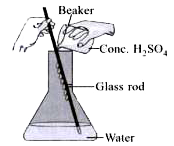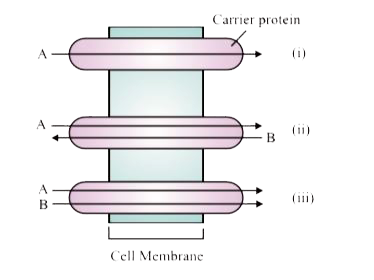Observe the given figure carefully and choose the incorrect statement(s).

I. Large volume of acid should be added to a small volume of water slowly.
II. The figure represents the process of concentrating dilute H2SO4.
III. The process involves release of a large amount of heat.
IV. Water should not be stirred.
I and IV only
II and III only
I, II and IV only
II only
The correct Answer is:C
Small volume of acid should be added to a large volume of water slowly. The figure represents the process of dilution of concentrated H2SO4. Water should be stirred continuously so that the mixture does not splash out.
Topper's Solved these Questions
- NSO QUESTION PAPER 2017- 18 SET - BBOOK - SCIENCE OLYMPIAD FOUNDATION CHAPTER - NSO QUESTION PAPER 2017- 18 SET - BEXERCISE - ACHIEVERS SECTION
3 Videos
- NSO MODEL TEST PAPER 03BOOK - SCIENCE OLYMPIAD FOUNDATION CHAPTER - NSO MODEL TEST PAPER 03EXERCISE - ACHIEVERS SECTION
2 Videos
- NSO QUESTION PAPER 2017-18 SET ABOOK - SCIENCE OLYMPIAD FOUNDATION CHAPTER - NSO QUESTION PAPER 2017-18 SET AEXERCISE - SCIENCE
10 Videos
Similar Questions
Knowledge Check
The volume of water to be added to 100 mL of 0.5N H2SO4 acid solution to get solution of decinormal concentration is :
A400 mLB450 nLC500 mLD100 mLObserve the given heating curve of ice carefully and select the correct statement(s) about it.

(i) Point p is the freezing point of water.
(ii) Between the points q and r water exists in liquid state.
(iii) After points, water vapours condense back to liquid water on further increasing the temperature.
(iv) Point r is the boiling point of water.A(ii) and (iii) onlyB(iii) onlyC(i) and (iv) onlyD(i), (ii) and (iv) onlyA : Dissolution of concentrated H2SO4 in water is highly exothermic process .
R : Sulphuric acid is always diluted by adding acid to water slowly .AIf both Assertion & Reason are true and the reason is the correct explanation of the assertion , then mark (1)BIf both Assertion & Reason are true but the reason is not the correct explanation of the assertion , then mark (2)CIf Assertion is true statement but Reason is false , then mark (3)DIf both Assertion and Reason are false statements , then mark (4)
Answer question numbers (a) – (d) on the basis of your understanding of the following paragraph and related studied concepts.
The process of dissolving an acid or a base in water is a highly exothermic one. Care must be taken while mixing concentrated nitric acid or sulphuric acid with water. The acid must always be added slowly to water with constant stirring. If water is added to a concentrated acid, the heat generated may cause the mixture to splash out and cause burns. The glass container may also break due to excessive local heating. Look out for the warning sign on the can of concentrated sulphuric acid and on the bottle of sodium hydroxide pellets. Mixing an acid or base with water results in decrease in the concentration of ions (H3O+/OH−) per unit volume. Such a process is called dilution and the acid or the base is said to be diluted.
How should acids be diluted ?
View SolutionAnswer question numbers (a) – (d) on the basis of your understanding of the following paragraph and related studied concepts.
The process of dissolving an acid or a base in water is a highly exothermic one. Care must be taken while mixing concentrated nitric acid or sulphuric acid with water. The acid must always be added slowly to water with constant stirring. If water is added to a concentrated acid, the heat generated may cause the mixture to splash out and cause burns. The glass container may also break due to excessive local heating. Look out for the warning sign on the can of concentrated sulphuric acid and on the bottle of sodium hydroxide pellets. Mixing an acid or base with water results in decrease in the concentration of ions (H3O+/OH−) per unit volume. Such a process is called dilution and the acid or the base is said to be diluted.
What will be the consequences if dilution of acid is not carried out slowly?
View SolutionAnswer question numbers (a) – (d) on the basis of your understanding of the following paragraph and related studied concepts.
The process of dissolving an acid or a base in water is a highly exothermic one. Care must be taken while mixing concentrated nitric acid or sulphuric acid with water. The acid must always be added slowly to water with constant stirring. If water is added to a concentrated acid, the heat generated may cause the mixture to splash out and cause burns. The glass container may also break due to excessive local heating. Look out for the warning sign on the can of concentrated sulphuric acid and on the bottle of sodium hydroxide pellets. Mixing an acid or base with water results in decrease in the concentration of ions (H3O+/OH−) per unit volume. Such a process is called dilution and the acid or the base is said to be diluted.
Tell whether heat is absorbed or evolved when an acid or base is dissolved in water
View SolutionAnswer question numbers (a) – (d) on the basis of your understanding of the following paragraph and related studied concepts.
The process of dissolving an acid or a base in water is a highly exothermic one. Care must be taken while mixing concentrated nitric acid or sulphuric acid with water. The acid must always be added slowly to water with constant stirring. If water is added to a concentrated acid, the heat generated may cause the mixture to splash out and cause burns. The glass container may also break due to excessive local heating. Look out for the warning sign on the can of concentrated sulphuric acid and on the bottle of sodium hydroxide pellets. Mixing an acid or base with water results in decrease in the concentration of ions (H3O+/OH−) per unit volume. Such a process is called dilution and the acid or the base is said to be diluted.
What is meant by dilution of an acid or a base ?
View Solution(a) Observe the given figure and give the answers of the following :-

(a) Identify the process occurring in (I), (II) and (III).
(b) Differentiate between the process II and III.
(c) How many types of aquaporins from the water channels in the cell membrane.
View Solution
